#mayaposts
Text
I feel like some people within the aspec community need to check themselves for aphobia like it's seriously concerning. I'm not just talking about internalized aphobia btw, I'm also talking about straight up aphobia against other members of the community.
If you're ace, that does not mean you are immune to being arophobic. Same goes if you're aro, you are not immune to being acephobic.
If you're aroace, you could also be aphobic without it necessarily being what could be considered as "internalized" (e.g. being aphobic to a favorable aroace when you're repulsed, being aphobic to aroaces who are non-partnering when you're partnering, being aphobic to loveless aros when you aren't loveless or lovequeer aros when you aren't lovequeer, etc. etc.).
That's not even talking about the amatonormativity in the community either.
#mayaposts#aro#ace#aroace#aspec#aphobia#arophobia#acephobia#aspec community#aro community#ace community#aroace community#aromantic#asexual#aromantic asexual#aro week 2024#aromantic awareness week
710 notes
·
View notes
Text
I just realized that Percy was willing to sacrifice himself for Annabeth and Grover in the newest episode and honestly that probably fucked up the two of them when he did that. They didn't know that Poseidon was literally gonna pull a deus ex machina on Percy to save him from the chimera and for all they know he was gonna meet the same fate as Thalia, another forbidden child who sacrificed herself to keep the two of them alive.
#mayaposts#pjo#percy jackson#percy jackon and the olympians#percy jackson and the olympians#annabeth chase#grover underwood#thalia grace
511 notes
·
View notes
Text
It's a little funny and a bit odd to me that there are some people who still don't take fanfiction seriously regardless of its content or even understand what it is. I could point out that there's a lot of literary classics that could be considered as fanfic, but honestly I'd rather just talk about how my dad uses them to teach his students.
My dad is a college professor that teaches legal writing for pre-law school students and one of the things he often does is assign classical books to students to read to get them used to reading English because not everyone here is that good at that. Reading is a good way to familiarize yourself with how a language works especially in formal settings and let's you learn words that you may not be familiar with.
Okay, you improved reading ability, that doesn't really improve writing and not everyone wants to start writing long documents in legalese. My father decided that an easy way to get people invested is to use what they learned from he stories and have his students make their own continuations or plotlines — he makes them write fanfiction. He didn't call it that until we brought up that it sounds like fanfiction and we've been calling it that since. He makes his students write what are essentially alternate endings, fix-it fics, and continuations and at times, even RPF.
One of his students, who was once my sister's classmate at high school so that's why he brought him up, wrote an RPF story where he was a general in the war and my dad was once a lower ranked officer who got killed in action and then submitted that for an assignment like that's objectively funny that my dad just accepted a fic where he dies written by this 19-year-old.
Writing these stories may seem silly but they genuinely improve your writing ability and especially if you were not that familiar with writing in the language you're writing for.
He's not even the only teacher that uses fanfic to engage with students since I myself had had teachers that essentially made us do the same thing. Hell, I had a writing teacher in art school that made money off of Wattpad before too and was very open to fanfic.
It cannot be understated how something as silly as fanfic has genuinely helped so many people learn how to write even professionally and especially for people who may not be that used to a the secondary language they needed to write in.
60 notes
·
View notes
Text
Here's your gentle reminder that your mental illness or disability could only be an explanation for your actions NOT an excuse for them.
If you do something shitty, own up to it and apologize if necessary without using your condition as an excuse. Making your condition your shield from being called out for bad actions would hurt people with that same condition since it would contribute to the stigma for those conditions.
It's okay to make mistakes, just learn how to own up to it.
#mayaposts#disability#mental disability#mental illness#actually disabled#actually neurodivergent#neurodivergent#also call out anyone who uses their disability/mental illness as an excuse#that also included me if i ever come to that btw#anw just peeved off in general abt a guy i knew who did this shit
3 notes
·
View notes
Text
As much as we all mourn about Solar, Please please pleasee do not threaten the VA like thats too far
284 notes
·
View notes
Text
casual displays of intimacy my beloved. a hand on their knee, your arm looped around theirs, your shoulders knocking together, etc.
#yearning hours#i just saw a very sweet couple of the bus and they inspired this post fhfjjfjt#maya if you see this you are seeing an almost gc text turned tumblr post#mayaposting
2 notes
·
View notes
Text
i don't get very many bots following this blog as i do my main but well at least im doing numbers in what i think is the cpr fetish community. who have mistaken my blog title for something very different indeed.
#im gonna change it to seven heartbeats (i.e. the platonic ressurection of a sentient sword)#i took 1 screenshot and then i blocked them but holy shit my world is open i had no idea a person could get off 2 a conceptual stethoscope#i mean do what u gotta do brother no judgement but also no mayaposting maybe
17 notes
·
View notes
Text
MISS MAYA HAWKE 😍😳🥰❤️😊😘🥵😩🥴

#maya hawke#mayaposting#yes that is a tag i made#im bisexual did u know#yeah im so very bisexual#i love women 😍#especially my drop dead gorgeous wife maya <3
10 notes
·
View notes
Text
I realized this week that, for the last year or so, I’ve been unintentionally housekeeping the loose ends from my twenties just before they’re over
It feels very liberating 😌
#mayaposting#moodboard#I know I know there’s no such thing as actually tying it all up in a neat bow#but it does feel like I’m finally taking my anxieties and shortcomings head on#grateful for the people and experiences that have led me here
0 notes
Text
it’s mayaposting hours
#ace attorney#ace attorney memes#ace attorney shitposts#maya fey#phoenix wright#my art#ifieatedsoaps soaps#ace attorney tiktoks
154 notes
·
View notes
Text
What's up with controversial YouTubers constantly blaming ADHD for their rancid actions like... that's not how ADHD fucking works??? It could worsen some issues you have and even be the reason for some but it wouldn't make you a fucking asshole????
#mayaposts#adhd#actually adhd#yes this is about#james somerton#but also like a lot of other creators im sure youve thought of some already#in the james somerton case he fucking blamed that for PLAGIARISM#as someone adhd i put so nuch effort in fucking citations so i dont forget what the fuck do you mean
550 notes
·
View notes
Text
After reading fWhip's reasoning for the "No Lore" rule, I can't blame him. What "lore" is within mcrp has gained connotations from the past few years of people using it just for the big stuff which puts so much pressure on creators to create big events and storylines even if it isn't a good fit for them.
Other than that, how fWhip describes how lore was treated behind the scenes is so confusing because honestly, it just sounds like some of them have poor roleplay etiquette. You don't just ask people to fill a certain role for your storyline out of nowhere especially if there's no discussion beforehand. You have to work together to write joint lore instead of putting them in an awkward position to roleplay out of character and in a way they aren't comfortable with or awkwardly reject the request. Besides this, just barring people from interacting with you because it messes with your lore is just weird like it's wild to put your lore above roleplaying in a roleplay server.
I understand that SMPs have this whole "everyone's the main character of their own POV" thing but you still have to be mindful of your fellow SMP members like that's the bare minimum when doing any roleplay. I hope this whole shift away from the big stuff reestablishes that lore isn't just the big stuff but the small stuff too because I do think that just making lore "big" was actually pretty damaging to mcrp long term.
238 notes
·
View notes
Text
Painting a picture of the history of Filipino Tattoos
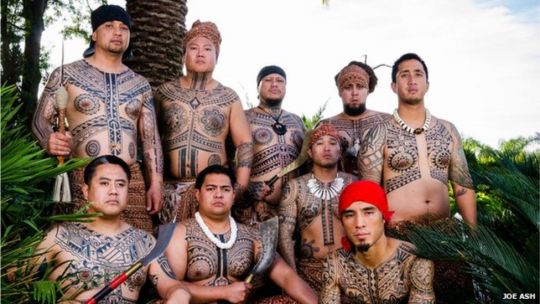
A photo of tattooed Filipino men posted on BBC and accredited to Joe Ash
Tattoos are often seen as integral cultural symbols in my different societies whether it be seen as something honorable or dishonorable. Even in the most straight-laced cultures, a tattoo acts as a mark of some form of the person's history and their standing in their communities as well as how people perceive them.
In a lot of modern cultures, the tattoo often have negative connotations, often associated with delinquency or criminal activity. Historically, however, they may have grander and more honorable significance in different societies. The communities that had existed in the Philippines prior to contact with Spain fits this similar pattern.
Before I start
As usual, the Philippines is a diverse country that has different traditions and histories that come from different ethnic groups and states, only being first unified under a government by colonization. Because of this, this post will only be able to cover parts of this culture and may not be able to fully encompass all Filipino traditions, practices, and beliefs about tattoos.
This is also given the fact that more specific information may be harder to come across or may not exist at all in a space I could easily access.
That being said, the general term for Filipino traditional (both precolonial and current) tattoo practices is batok, batik, patik, or patek depending on language or culture. It is also known as buri or burik in several other groups and languages. This word, however, isn't often used for typical tattooing in most modern communities.
The History
From a general understanding of a lot of precolonial Southeast Asian cultures, it can be assumed that precolonial Filipino societies heavily valued tattoos as their neighboring maritime SEAsian countries also had prior to the introduction of Abrahamic religions to the region which often discouraged or even forbade tattooing the skin.
Although this can be assumed, there were no known precolonial description nor record of these tattoos during the actual time period before Spanish contact. There is evidence found in some burial sites however, as discussed by social anthropologist Salvador-Amores in her paper The Recontextualization of Burik (Traditional Tattoos) of Kabayan Mummies in Benguet to Contemporary Practice (2012). In the paper, she focuses a section on the history of burik by explaining the Kabayan Mummies or the Fire Mummies of Benguet, Mountain Province.
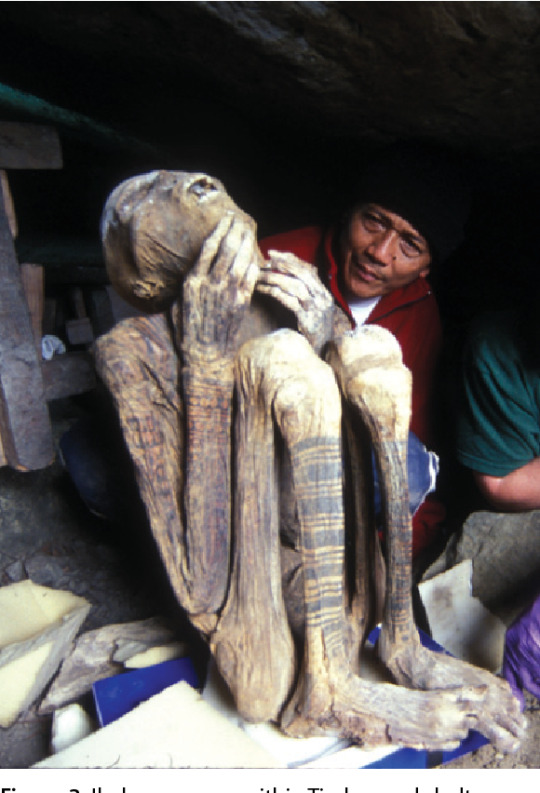
An image of one of the Kabayan Mummies uploaded by Dario Piombino-Miscali on ResearchGate.net
These remains had been dated back to the 13th century and are associated with the Ibaloi, an indigenous ethnic group from Mountain Province found in the northern parts of the island of Luzon. This does confirm that tattooing had been important to the people who had lived in this area during this time period as, in Salvador-Amores's paper, it can be noted that the tattooed mummies seem to be prominent with the adults.
I do have to note that the Ibaloi people, who are part of the larger Igorot ethnic group, were not fully colonized by the Spaniards and therefore does not share the similar Hispanic culture and history that a lot of Filipino groups have. They had only fully been integrated into the Philippines during the American colonial period where they and the other Igorots had been properly colonized by American and placed under the rule of the American-controlled Filipino government. (x)
Regardless, this does show that at least some cultures in the archipelago held tattoos with high importance and did not consider them as something negative compared to the modern perception of tattoos.
The first known illustration of tattooed Filipinos, however, was first seen in the Boxer Codex (circa 1590) during the early Spanish colonial period, written and illustrated by an unknown author.
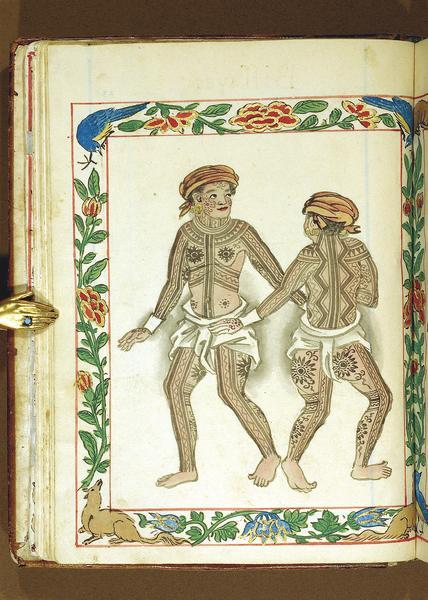
A page from the Boxer Codex (circa 1590), author uknown
This illustration seems to be that of the specific ethnolinguistic group, the Visayans as this page is next to another one labeled as "Biſſaya", a likely earlier spelling of Bisaya that uses the long s (ſ). This aligns with the description given as early as Antonio Pigaffatta, Ferdinand Magellan's chronicler, who consistently describes the Visayans that he has met as painted in his account of their arrival in the islands back in 1521.
The book The Philippine Islands 1493-1898 Vol. XII has compiled different first-hand and second-hand sources about the Philippines during the 15th through 19th century, with Vol. XII focusing on the early 17th century which aligns closely to the Boxer Codex. Within the text, there are several mentions of the "Pintados" or the Painted ones, even having an entire province be called the "province of Pintados".
It isn't made clear who the Pintados are besides the fact that they seem to be hostile towards the Spanish colonizers and had often fought battles with one of the letters even claiming that they had poisoned one of the Spaniards. It isn't until we reach the last part of the compilation which features Pedro Chirino's Relacion de las Yslas Filipinas which I had a hard time finding before but had now found a free and accessible copy. Within Chirino's writing, he explains that the Pintados seem to be a name given by the Spaniards to the Bisayans and further explains it as such:
"The people of the Bisayas are called the Pintados, because they are actually adorned with pictures --not because this is natural to them, although they are well built, of pleasing countenance, and white; but because they adorn their bodies with figures from head to foot, when they are young and have sufficient strength and energy to suffer the torment of the tattooing; and formerly they tattooed themselves when they had performed some act of valor."
Chirino even gives an explanation as to how precolonial Visayans tattooed their skin:
They tattoo themselves by pricking the skin until the blood comes, with sharp, delicate points, according to designs and lines which are first drawn by those who practice this art; and upon this freshly-bleeding surface they apply a black powder, which is never effaced. They do not tattoo the body all at the same time, but by degrees, so that the process often lasts a long time; in ancient times, for each part which was to be tattooed the person must perform some new act of bravery or valiant deed
It is notable, however, that not only did the Spanish not mention any tattoos on other Filipino groups such as the Tagalogs, but a lot of the illustrations in the Boxer Codex do not sport any tattoos at all which makes it confusing as to when had tattoos faded out of cultural significance in these other communities, likely even before Spanish contact.
Lane Wilcken, a researcher who studies the history of tattoos from the Philippines and the Pacific Islands, writes in his book Filipino Tattoos: Ancient to Modern (2010) that it may be possible that the Tagalogs may had lost their tattooing traditions shortly before Spanish contact during the recent islamization of their communities circa 1500 which was and specifically in the polity of Maynila. This may also be the case for the Moros which is a muslim ethnolinguistic group found in the island of Mindanao.
Either way. tattoos became more scarce within Filipino records after the arrival of the Spanish and the introduction of Christianity to the islands, save for some indigenous groups that were not fully colonized by Span like previously mentioned Igorot people.
Because of the spread and dominance of Christian and Islamic customs throughout the country, Batok, as it originally was, was lost to time with the lack of existing artists and cultural relevance tattoos. Tattoos didn't come back to the Filipino mainstream until modern tattoos became more prevalent especially in the mid to late 20th century, similar to its rise in popularity in Western cultures, and even then, it wasn't really what I would consider any traditional and is often negative.
Present Day
Like a lot of other countries, however, tattoos had seen a swing of opinion and is more accepted now as an art form rather than a sign of criminal activity but some stereotypes are still popular.
For instance, during the COVID-19 lockdown, the Department of Education provided modules for students to answer at home which would be then collected by the school from door to door. In one of these modules, Lea Salonga, a Filipino singer, complained on November 17, 2020 on her Facebook page of a discriminatory question that was found in one of the modules, pictured below
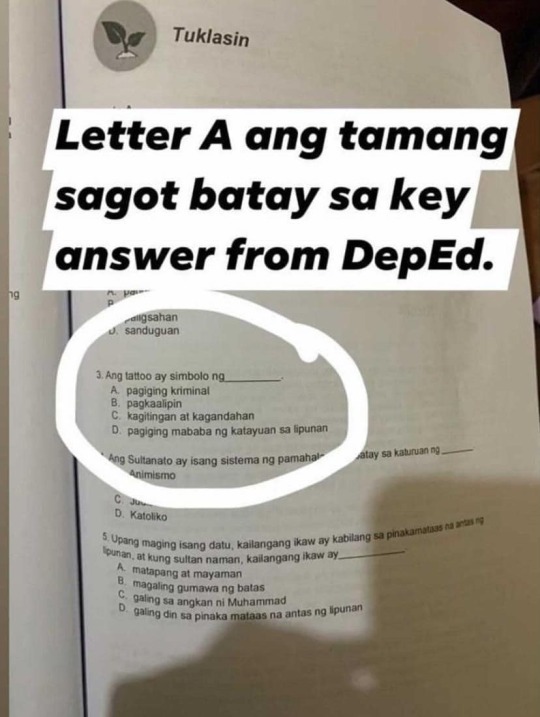
EN Translation:
White text: The answer is letter A based on the DepEd answer key.
Module text:
3. Tattoos are a symbol of _____
A. being a criminal
B. being a slave
C. courage and beauty
D. having a low standing in society
This controversy caused an uproar online and showed that there are a lot of Filipinos today that don't see a problem with tattoos and even see them as a positive. Two days after the image was posted on Salonga's page, the Department of Education publicly recognized the misstep and had issued that they officially recognized the controversial answer as an error.
It is important for me to note that, just like in a lot of countries, tattoos are typically not accepted in the corporate world and those who have them either have to get them removed or at least cover them up if they get hired at all. There's still a common idea that people with tattoos, if not dangerous, may be seen as unprofessional or even unclean which I do know is a similar thing that other countries may have as well.
As for batok, its comeback in the larger Filipino mainstream didn't return until some time in the late 2000s and 2010s when more international influence had resparked and interest in more ethnic cultures including the precolonial Filipino tattoos specifically because of the internet and the rise of social media. The current batok that we see outside of indigenous communities could be seen as a recreation of the extinct practices within the Philippines with some level of appropriation from related cultures (by appropriation, I mean this in a neutral way not a negative one).
It is argued whether or not the reconstructed practice could be considered traditional at all, but considering its heavy emphasis on the older designs found in historical illustrations as well as designs from indigenous communities that did not have practice eradicated by colonization, some also argue that the modern tattoos that has gained prominence because of modern technology and research is still valuable in a socio-anthropological sense.
As Salvado-Amore puts it
the successive phases and changes in the status of burik tattoos—enabled by the advent of modern technology, the Internet, and mass media—encourage an interaction between contemporary and historical influences rather than an extinction of past practice.
About Apo Whang-Od
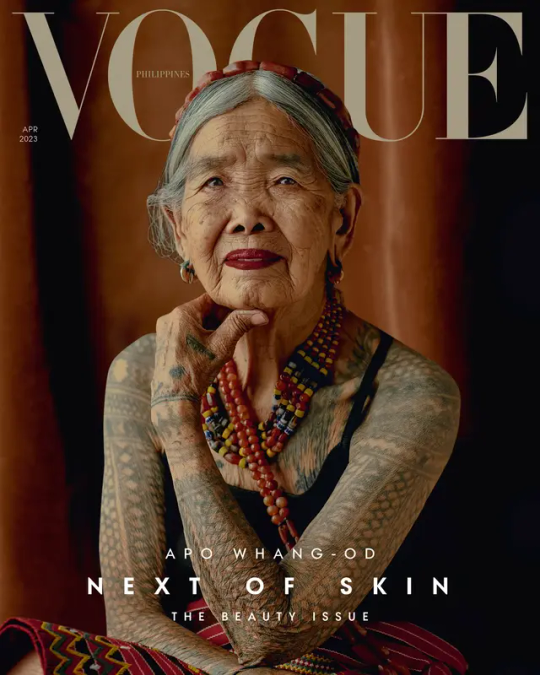
A magazine cover of Vogue featuring Whang-Od, a traditional tattoo artist from the Butbut people, a subgroup within the Kalinga ethnic group. (The rest of this section pulls from the same article by Vogue)
Any research about Filipino tattoos, especially in the modern day would be incomplete without any mention of Whang-Od, the most popular traditional tattoo artist from the Philippines.
Apo Whang-Od (b. February 17, 1917, a.k.a. Maria Oggay) is a member of the Butbut people of the Kalinga indigenous ethnic group from Kalinga province, Philippines. She is often known as one of the last mambabatok in the country which earned her fame and recognition internationally. She started her tattooing practice since she was a teenager at age 16, under the mentorship of her father and was the only known female mambabatok during her time.
For years, she was called on by different communities within her locale in order to tattoo important and symbolic tattoos on members of her and different communities after they had received certain milestones. Men were tattooed for different reasons than women as men were given their marks when they succeed in activities like headhunting, which was ritualistically important for the Butbut people while women were tattooed for reasons like fertility or beauty.
Because of American colonization, however, headhunting was prohibited so she was mostly tattooing women from then onward.
She started gaining recognition some time in the mid-2000s to the 2010s after she started serving foreign tourists, although she doesn't give them the more traditional symbols. Non-members of the group are given a set of tattoos that she could tattoo on anyone without any strong connection to the original meaning of the art.
Since tattooing was passed through family and Whang-Od herself didn't had any children, she was known as the last mambabatok for a time which caused concern for the extinction of the practice as she was already in her 90s when she gained notoriety, but she has since started training her grandniece Grace Palicas and later on her other grandniece Elyang Wigan and the two, who are now in their 20s, has since helped their great aunt dealing with their clientele.
Due to her fame, she is often the subject of foreign media and interest, even being invited by Vogue magazine to pose for one of their covers (pictured above) and is now known as the oldest Vogue cover model earlier this year at the age of 106.
Despite her fame and arguably cultural importance to not only the Kalinga people but the Philippines as well as online petitions since the 2010s to give her the recognition, she is not eligible to receive the National Artist award— one of the highest awards given to artists of most artistic fields of which only 81 people had received. Victorino Manalo, Chairman of the National Commission for Culture and Arts (NCCA) explains that this is because her craft, tattooing, isn't covered by the NCCA but by the Gawad sa Manlilikha ng Bayan (GAMBA, en. Award for Crafters/Creatives of the Nation) but there has been some discussion within the commission about this issue which still ended with her being denied. In light of this, she is now currently on the running to possibly receive the GAMBA award.
She has an online presence managed by others and she can be found via Facebook and Instagram.
Tattoos now, from my experience
As I had said before, tattoos these days are not as negatively seen as they were in the 20th century and had received a more positive reputation thanks to the rise of its social experience due to the internet and social media's prevalence in the country. As an art student, in fact, it's wasn't that surprising when I learned that one of my classmates had a tattoo and it was even a full sleeve! Now, as least three had tattoos before they graduated with one of them actually being a close friend of mine who's planning to get more despite their parents' disapproval.
Despite this, I still do have people in my life right now that see tattoos as undesirable and unclean, with stereotypes still being prevalent. I had once heard people speak of them in such a negative way but then make an exception for the artsy type of people? It's odd.
As for batok or batik, I had not seen a lot of people with these tattoos in my own life and had only seen it through articles and images circulated around by other people who I don't even know. I guess it makes sense as most people who do get tattoos similar to batok or batik often do it in tourist-y places or are foreigners who want to get a piece of Filipino culture on their way out of the country.
Besides more culture-focused people, batik or batok isn't as prevalent as some of these articles might make it seem and most typical Filipinos who don't come from these cultures are more likely to either not have tattoos at all or have similar tattoos to those that you may see in other countries.
Either way, tattoos could be so personal to a person and whether it's something as deeply-rooted to culture like batik or if it's just the names of your favorite K-Pop idol, that tattoo is important and has special meaning. Get whatever tattoo that you want or don't if you don't want any at all!
#mayaposts#mayapino#philippines#filipino#philippine history#philippine culture#filipino culture#filipino tattoos#philippine tattoos#history#culture#tattoos#apo whang-od#whang-od#mummy#mummies#death#long post#very long post
76 notes
·
View notes
Text
One thing that I'm definitely happy about with the progress of neurodivergency activism is the fact that nd kids who would've been overlooked otherwise because they mask it well are now learning about themselves and getting help and resources or are now being noticed to get that help and resources.
It's definitely not something that's widespread and misinformation and stigma is still definitely causing loads of problems but it's good progress from when that time my ADHD was dismissed by several professionals because I was "doing very well in school" or that I was "too old."
Even with the progress though, it's still super important that we don't stop the conversation even if it's just online. The more we talk, the less they ignore us.
4 notes
·
View notes
Text
youtube
I... I dont think I ever share this here, did I? I dont think so. Well it's a month old but Im yeet this here
#mayapost#mayaart#tsams#sun and moon show#tsams sun#tsams bloodmoon#Youtube#epic the musical#animatic
165 notes
·
View notes



